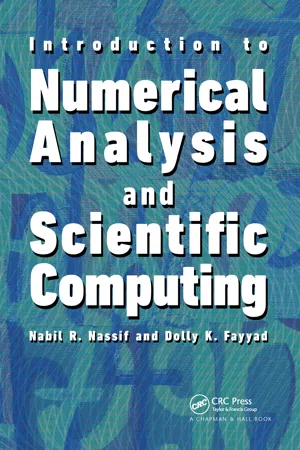
eBook - ePub
Introduction to Numerical Analysis and Scientific Computing
Nabil Nassif, Dolly Khuwayri Fayyad
This is a test
Compartir libro
- 329 páginas
- English
- ePUB (apto para móviles)
- Disponible en iOS y Android
eBook - ePub
Introduction to Numerical Analysis and Scientific Computing
Nabil Nassif, Dolly Khuwayri Fayyad
Detalles del libro
Vista previa del libro
Índice
Citas
Información del libro
Designed for a one-semester course, Introduction to Numerical Analysis and Scientific Computing presents fundamental concepts of numerical mathematics and explains how to implement and program numerical methods. The classroom-tested text helps students understand floating point number representations, particularly those pertaining to IEEE simple an
Preguntas frecuentes
¿Cómo cancelo mi suscripción?
¿Cómo descargo los libros?
Por el momento, todos nuestros libros ePub adaptables a dispositivos móviles se pueden descargar a través de la aplicación. La mayor parte de nuestros PDF también se puede descargar y ya estamos trabajando para que el resto también sea descargable. Obtén más información aquí.
¿En qué se diferencian los planes de precios?
Ambos planes te permiten acceder por completo a la biblioteca y a todas las funciones de Perlego. Las únicas diferencias son el precio y el período de suscripción: con el plan anual ahorrarás en torno a un 30 % en comparación con 12 meses de un plan mensual.
¿Qué es Perlego?
Somos un servicio de suscripción de libros de texto en línea que te permite acceder a toda una biblioteca en línea por menos de lo que cuesta un libro al mes. Con más de un millón de libros sobre más de 1000 categorías, ¡tenemos todo lo que necesitas! Obtén más información aquí.
¿Perlego ofrece la función de texto a voz?
Busca el símbolo de lectura en voz alta en tu próximo libro para ver si puedes escucharlo. La herramienta de lectura en voz alta lee el texto en voz alta por ti, resaltando el texto a medida que se lee. Puedes pausarla, acelerarla y ralentizarla. Obtén más información aquí.
¿Es Introduction to Numerical Analysis and Scientific Computing un PDF/ePUB en línea?
Sí, puedes acceder a Introduction to Numerical Analysis and Scientific Computing de Nabil Nassif, Dolly Khuwayri Fayyad en formato PDF o ePUB, así como a otros libros populares de Matemáticas y Matemáticas general. Tenemos más de un millón de libros disponibles en nuestro catálogo para que explores.
Información
Chapter 1
Computer Number Systems and Floating Point Arithmetic
1.1Introduction
1.2Conversion from Base 10 to Base 2
1.2.1Conversion of the Integral Part
1.2.2Conversion of the Fractional Part
1.3Conversion from Base 2 to Base 10
1.3.1Polynomial Evaluation
1.3.2Conversion of the Integral Part
1.3.3Conversion of the HYactional Part
1.4Normalized Floating Point Systems
1.4.1Introductory Concepts
1.4.2IEEE Floating Point Systems
1.4.3Denormalized Numbers in MATLAB
1.4.4Rounding Errors in Floating Point Representation
1.5Floating Point Operations
1.5.1Algebraic Properties in Floating Point Operations
1.5.2The Problem of Absorption
1.5.3The Problem of Cancellation or Loss of Precision
1.6Computing in a Floating Point System
1.6.1Cardinality and Distribution of Floating Point Systems
1.6.2A MATLAB Simulation of a Floating Point System
1.6.3Tips for Floating Point Computation
1.7Exercises
1.8Computer Projects
1.1 Introduction
The main objective of this chapter is to introduce the students to modes of storage of users’ numbers in a computer memory and as well providing the readers with basic concepts of computer arithmetic, referred to also as Floating Point Arithmetic. Although the principles covered are general and can apply to any finite precision arithmetic system, we apply those principles only to Single and Double Precision IEEE (Institute of Electrical and Electronics Engineers) systems. For additional detailed references, we refer to [8], [14], [19] and [23].
In this view, we start by describing computer number representation in the binary system that uses 2 as the base. Since the usual decimal system uses base 10, we discuss therefore methods of conversion from one base to another. The octal and hexadecimal systems (respectively, base 8 and base 16 systems) are also introduced as they are often needed as intermediate stages b...